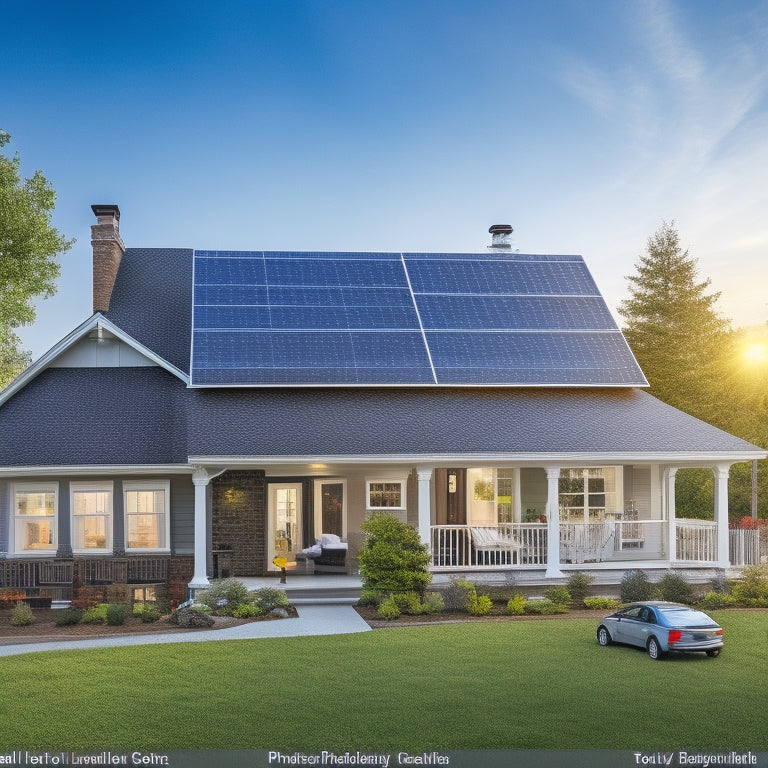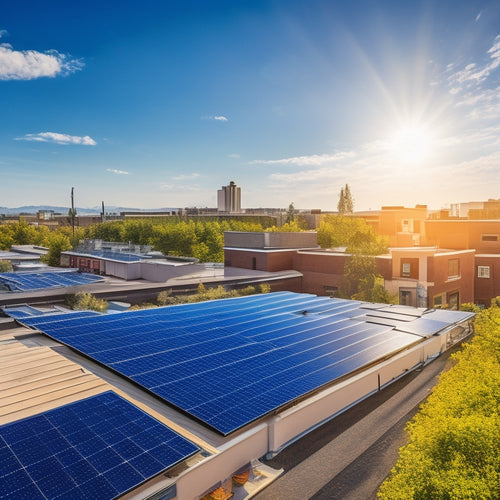
Why Do Residential Solar Panels Cost So Much?
Share
Residential solar panels are expensive primarily due to high material costs, manufacturing expenses, and advanced technology investments. About 60% of the total cost comes from materials like high-purity silicon and durable tempered glass, which guarantee efficiency and longevity. Manufacturing is costly due to the need for specialized equipment, skilled labor, and sourcing rare elements. Supply chain issues have driven up prices for key components like silicon, silver, and aluminum. Additionally, research and development for better energy conversion rates and overall performance add to the costs. Understanding these factors provides deeper insights into the pricing dynamics of solar panels.
Key Takeaways
- High-quality silicon and glass materials enhance efficiency but significantly increase costs.
- Rising prices of essential raw materials like silicon, silver, and aluminum elevate production expenses.
- Specialized equipment and skilled labor for advanced manufacturing techniques are costly.
- Investments in research and development for better efficiency drive up overall costs.
- Labor shortages and production inefficiencies escalate operational and labor expenses.
Material Costs
https://www.youtube.com/watch?v=cVT5HAjrHZM
When evaluating the cost of residential solar panels, you'll find that material costs typically account for around 60% of the total expenditure. Central to these material costs are the quality of silicon and glass used in the panels. High-purity silicon is essential since it directly affects the efficiency of energy conversion. You'll see that panels with higher silicon purity yield more power and, as a result, save more money in the long run, despite their higher upfront costs.
Additionally, glass quality plays a significant role. The glass must be durable enough to withstand harsh environmental conditions while allowing maximum light penetration. Low-iron tempered glass is often used due to its superior clarity and strength, ensuring long-term performance and reduced maintenance costs.
Understanding these material considerations empowers you to make informed decisions that could potentially liberate you from escalating electricity bills. Investing in high-purity silicon and top-grade glass might seem costly initially, but it's economically beneficial over time. Each component's quality contributes significantly to the panel's overall efficiency and lifespan, ultimately providing you with a more sustainable and cost-effective energy solution.
Manufacturing Expenses
When considering manufacturing expenses, you should account for the cost implications of material sourcing challenges, such as securing rare earth elements.
Advanced technology costs also play a significant role, as cutting-edge production techniques can be expensive.
Additionally, labor and production rates directly impact overall costs, with higher wages and faster production timelines increasing the financial burden.
Material Sourcing Challenges
The rising costs of raw materials like silicon, silver, and aluminum greatly impact the overall expenses of manufacturing residential solar panels. These key components face supply chain disruptions and resource scarcity, driving up prices. Silicon, the core element in solar cells, has seen price hikes due to limited production capacity and high demand. Silver, used for its excellent electrical conductivity, remains costly as mining struggles to keep pace with renewable energy demands. Aluminum, essential for panel frames, has also become more expensive due to global supply chain bottlenecks and increased transportation costs.
Here's a snapshot of the cost impact:
| Material | Average Price Increase (%) | Key Factors |
|---|---|---|
| Silicon | 30% | Production limits, high demand |
| Silver | 25% | Mining constraints, high usage |
| Aluminum | 20% | Supply chain, transport costs |
These rising costs directly affect the manufacturing expenses of solar panels. You can't overlook the economic pressures that manufacturers face. The scarcity of these essential resources means that producers must invest more to secure their supply chains, leading to higher prices for end consumers. Understanding these material sourcing challenges is important for grasping why residential solar panels remain a significant investment.
Advanced Technology Costs
Advanced technology in manufacturing residential solar panels considerably raises production costs due to the need for specialized equipment and highly skilled labor. Precision instruments are required to handle the delicate materials and processes involved in creating high-efficiency solar cells. These efficiency advancements often stem from extensive research investment, which incurs significant expenses long before production even begins.
For instance, the development of photovoltaic cells with improved energy conversion rates demands sophisticated machinery. This machinery not only costs millions but also requires continuous maintenance and upgrades. Additionally, integrating cutting-edge technology like multi-junction cells or bifacial panels into production lines necessitates specialized knowledge, pushing labor costs higher.
You're also paying for the years of research that go into increasing panel efficiency. Companies invest heavily in R&D to innovate next-gen solar technologies, aiming for higher output at lower sunlight levels. This investment is essential for achieving the liberation from traditional energy sources you desire. But it doesn't come cheap. Every breakthrough has a price tag, translating into higher costs for the end consumer.
Labor and Production Rates
Given the intricacies of manufacturing solar panels, labor and production rates profoundly impact overall costs. When you consider the significant labor shortages in the industry, it's clear why expenses are high. Skilled laborers are essential for ensuring quality and efficiency, yet the supply doesn't meet demand. This scarcity drives up wages, which in turn escalates the production costs.
Production inefficiencies also play a critical role. Manufacturing solar panels involves complex processes like silicon wafer production, cell assembly, and module encapsulation. Any bottlenecks or delays in these steps can lead to increased labor hours and higher operational expenses.
| Factor | Impact on Cost |
|---|---|
| Labor Shortages | Higher wages |
| Production Inefficiencies | Increased labor hours |
| Complex Manufacturing | Higher operational costs |
| Quality Assurance | Additional expenses |
Furthermore, the push for higher efficiency and durability in panels means more rigorous quality assurance protocols. These protocols require additional labor, further amplifying costs. By understanding these economic factors, you gain insight into why residential solar panels remain costly. However, as technologies and production methods improve, there's hope that these costs will eventually decline, liberating more households to harness solar energy.
Installation Labor
Labor costs for installing residential solar panels typically account for about 10% of the total system cost, making it a significant factor to take into account in your budget. A skilled workforce is essential for a successful installation. Technicians need to be proficient in electrical work, roofing, and system design. Their expertise guarantees that your solar panels operate efficiently and safely.
The complexity of installation often varies based on the roof's angle, material, and the electrical wiring of your home. Complex installations demand more labor hours, thereby increasing costs. This is particularly true for older homes where electrical systems might need upgrades to handle the new load. Additionally, labor rates can vary substantially by region. In areas with a higher cost of living, you'll find labor costs are proportionately higher.
Investing in experienced professionals may seem costly upfront, but it minimizes the risk of future issues, saving you money in the long run. Poor installation can lead to inefficiencies or even system failures, negating the economic benefits of solar energy. By understanding the labor component, you're better equipped to navigate the financial landscape of adopting solar technology.
Permits and Inspections
You'll need to budget for permits and inspections, which can add $500 to $2,000 to your total project cost. Regulatory compliance requirements vary by location, impacting both time and expense.
Additionally, inspection scheduling delays can extend your project timeline by several weeks, potentially increasing labor costs.
Regulatory Compliance Requirements
Understanding the regulatory landscape for residential solar panels involves obtaining the necessary permits and successfully passing multiple inspections to confirm compliance with local building codes and safety standards. Regulatory standards are strict, ensuring your installation is safe and efficient. These standards can lead to various costs, primarily through compliance fees and additional administrative expenses.
Here's a breakdown of the steps and associated costs:
| Regulatory Step | Associated Cost |
|---|---|
| Building Permit | $500 - $2,000 |
| Electrical Permit | $100 - $500 |
| Plan Review | $200 - $1,000 |
| Inspection Fees | $200 - $1,000 per visit |
Meeting these regulatory requirements isn't just about fulfilling requirements; it's about safeguarding your investment and ensuring long-term functionality. These fees can add up quickly, significantly impacting the overall cost of your solar panel installation.
The economic impact of regulatory compliance can't be underestimated. Compliance fees often vary dramatically based on your location, making it essential to understand your area's specific requirements. While these fees might seem burdensome, they're vital for maintaining high safety and quality standards in the solar industry. By overcoming these regulatory hurdles efficiently, you can enjoy the benefits of solar energy without unnecessary delays or additional costs.
Inspection Scheduling Delays
Understanding the regulatory landscape is only part of the challenge; inspection scheduling delays can greatly extend your project's timeline and inflate costs. Finding a way through the maze of permits and inspections involves coordination challenges that often lead to significant appointment backlogs. These delays aren't just inconvenient—they can directly impact your finances and project efficiency.
Consider the following factors that contribute to inspection scheduling delays:
-
Limited inspector availability: Local governments often lack sufficient inspectors to handle the growing number of solar installations, leading to long wait times.
-
Complex coordination: Synchronizing schedules between installers, inspectors, and homeowners is often a logistical nightmare, further delaying the project.
-
Regulatory inconsistencies: Different jurisdictions have varying requirements and timelines, making it difficult to predict and manage the inspection process.
Data from the National Renewable Energy Laboratory indicates these delays can add several weeks to your project timeline, increasing labor and administrative costs by up to 15%.
Plus, appointment backlogs mean your system sits idle, delaying the start of energy savings and potential credits. For those seeking to liberate themselves from high utility bills, these inefficiencies can be frustrating and costly.
Reducing these delays requires streamlined processes and better communication between all parties involved, ensuring a quicker, more cost-effective shift to solar energy.
Inverter and Battery
The inverter and battery system, essential components of a residential solar setup, directly impact both the efficiency and cost-effectiveness of your investment. The inverter converts the direct current (DC) produced by solar panels into alternating current (AC) for home use. High-quality inverters can greatly enhance system efficiency, ensuring you get the most out of your solar panels.
Adding a battery system enhances grid independence by storing excess energy for use during peak times or power outages. However, these systems come with a substantial price tag. Lithium-ion batteries, the most common choice, offer high efficiency and longer life but are expensive.
| Component | Cost Range |
|---|---|
| Inverter | $1,000 - $3,000 |
| Battery System | $5,000 - $15,000 |
| Installation | $500 - $2,000 |
| Maintenance | $100 - $500/year |
Investing in a top-tier inverter and battery can greatly reduce utility bills over time, but the initial costs are steep. While the upfront investment may seem challenging, the long-term benefits include not just financial savings but also increased energy autonomy, freeing you from the constraints of the grid. The key is balancing the immediate costs with the future benefits to achieve true energy liberation.
Incentives and Rebates
To offset the high initial costs of inverters and battery systems, numerous federal, state, and local incentives and rebates are available, greatly reducing the overall investment in residential solar panels. These financial aids are designed to make solar energy more accessible, fostering a cleaner and more sustainable future.
Consider these key incentives:
-
Federal Investment Tax Credit (ITC): You can claim 26% of your solar system's cost on your federal tax return, greatly lowering your tax liability.
-
State-specific rebates: Various states offer rebates that can further reduce your installation costs. For example, California's Solar Initiative provides substantial rebates based on performance metrics.
-
Local utility incentives: Many local utilities offer rebates or performance-based incentives to encourage solar adoption, which can add up to significant savings.
Government subsidies play an essential role in making solar panel systems financially viable. These subsidies not only reduce the payback period but also increase the return on investment.
Tax credits are another powerful tool, directly reducing the amount of tax you owe, thereby freeing up more capital for other endeavors. By leveraging these financial mechanisms, you can achieve energy independence while contributing to environmental sustainability.
This strategic approach not only makes solar panels more affordable but also aligns with a future-focused, liberated lifestyle.
Maintenance and Repair
Regular maintenance and timely repairs can prolong the lifespan of your residential solar panels, guaranteeing peak performance and maximizing your investment. Cleaning frequency is essential. Dust, debris, and bird droppings can obstruct sunlight, reducing efficiency by up to 20%.
Ideally, you should clean your panels every six months, though more frequent cleaning may be necessary in dusty or heavily polluted areas.
Component lifespan is another significant factor. Solar panels themselves can last 25-30 years, but inverters typically need replacement every 10-15 years, adding to your maintenance costs. Monitoring systems, which track your system's performance, usually have a lifespan of 5-10 years.
Regular inspections can identify potential issues early, preventing costly repairs. For example, checking for loose connections or corrosion can save you hundreds of dollars in the long run.
Economically, while the initial outlay for maintenance might seem high, it ensures your solar panels operate efficiently, reducing your reliance on grid electricity and lowering your energy bills.
Investing in a professional maintenance service can cost around $150-$300 annually, but this is a small price to pay for the substantial benefits of sustained high performance and extended component lifespan.
Long-Term Savings
Investing in residential solar panels can lead to notable long-term savings, with data showing potential reductions in electricity bills by up to 70%. By harnessing the power of the sun, you're not just cutting monthly costs but also securing energy independence. This financial liberation means you're less vulnerable to utility rate hikes and can enjoy more predictable energy expenses.
Consider these key benefits:
-
Return on Investment (ROI): A typical solar panel system can pay for itself within 7-10 years, after which the electricity generated is basically free.
-
Increased Property Value: Homes equipped with solar panels often see a rise in market value, potentially recouping the initial investment if you decide to sell.
-
Tax Incentives and Rebates: Federal and state programs offer incentives that can significantly offset installation costs.
Additionally, the environmental impact can't be ignored. Solar panels reduce reliance on fossil fuels, significantly decreasing your carbon footprint. Over a 25-year span, a single residential system can offset approximately 100,000 pounds of carbon dioxide emissions.
Frequently Asked Questions
How Does the Location of a Home Affect Solar Panel Costs?
Imagine planting a tree: soil quality matters. Similarly, your home's location affects solar panel costs due to local incentives and regional taxes. Urban areas might offer better incentives, reducing costs, while rural areas could face higher expenses.
Can the Design of My Roof Influence the Price of Solar Panels?
Yes, your roof's orientation and material have a substantial impact on solar panel costs. South-facing roofs maximize efficiency, reducing long-term expenses. Conversely, unconventional materials or complex designs increase installation complexity and labor costs, affecting initial investment.
Are There Financing Options Available to Help With the Initial Cost?
Imagine harnessing the sun's potential with government incentives and lease options. These financial aids can greatly reduce your upfront costs, liberating you economically, and making solar energy accessible while promoting sustainable living.
How Do Market Demand and Supply Chains Impact Solar Panel Prices?
When market growth outpaces supply, it creates supply constraints that drive up solar panel prices. High demand strains production capabilities, leading to increased costs for materials and labor, which ultimately impact your purchase price.
Does the Experience Level of the Installation Company Affect Overall Costs?
Imagine paying for a gourmet chef versus a novice cook. The installer reputation and installation efficiency greatly influence costs. Experienced companies often charge more, but their efficiency reduces errors and long-term expenses, offering greater economic liberation.
Related Posts
-

Solar Energy Benefits for Sustainable Living
Solar energy provides numerous benefits for sustainable living that you can't overlook. By switching to solar, you'll...
-

Solar Inverter Troubleshooting for Beginners
Troubleshooting your solar inverter starts with understanding its efficiency and performance metrics. Check for prope...
-

Solar Energy Solutions for Small Businesses
Switching to solar energy can be a game changer for your small business. You'll enjoy significant cost savings on mon...


